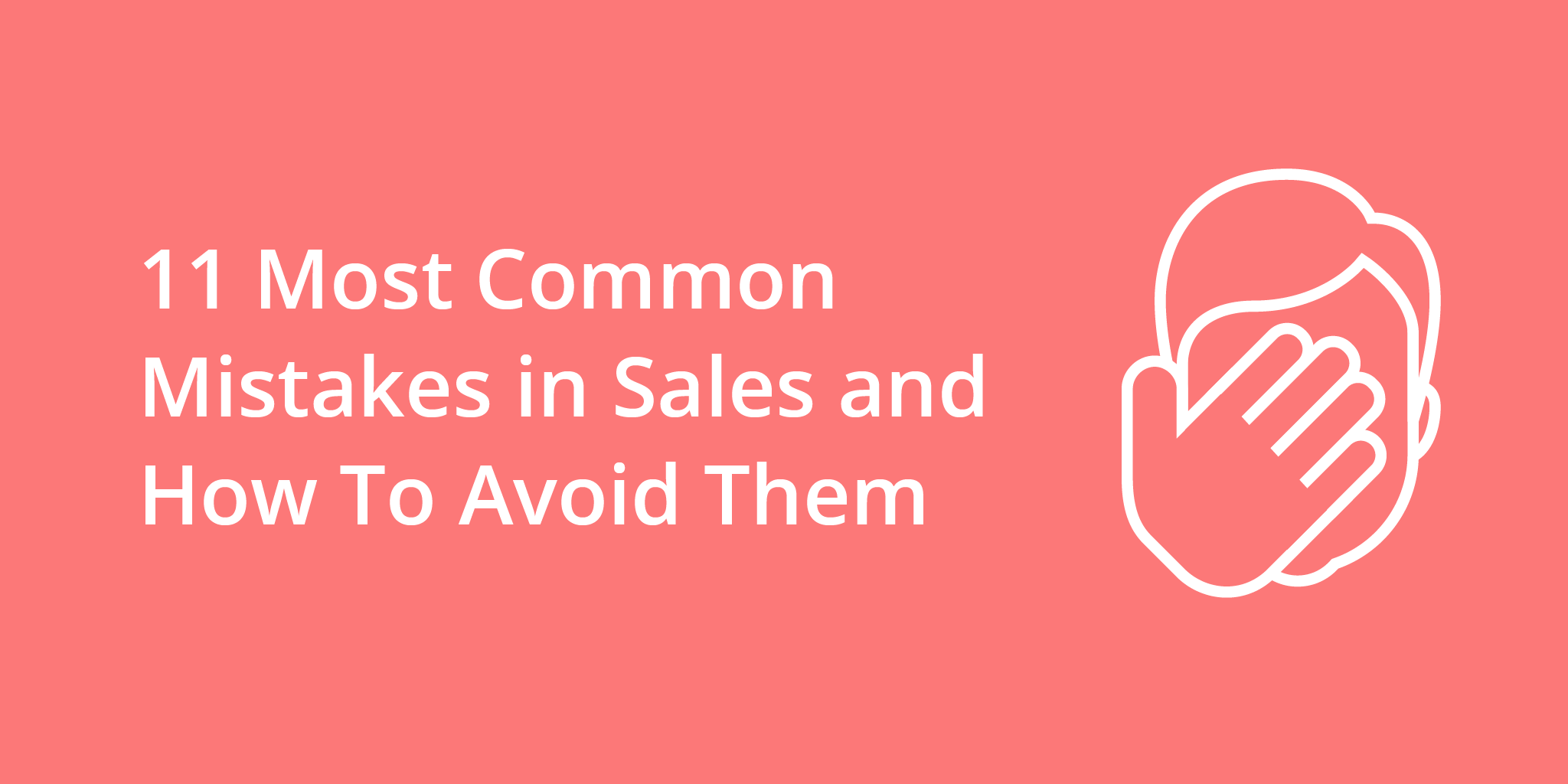
On average, it takes up to 10 months for a new sales rep to be productive. So if you’re not a sales veteran with years under your belt and impeccable achievements, you probably still have at least a few things to learn.
One of the most effective ways to keep improving over time is to learn from your mistakes. It’s even more ideal to learn from the mistakes of others, so that you don’t ever have to make those mistakes yourself.
This article compiles 11 of the most common sales mistakes that sales representatives make, and how you can avoid them. There’s definitely more to learn about the craft of sales than these, but if you are able to master them and improve, you’ve got 80% of your sales problems covered.
Sales Mistakes in Poor Lead Qualification
One of the biggest mistakes salespeople make is to ignore the quality of leads. The sales process takes time and, depending on your industry, you may have to spend up to several months working with a potential client.
So, just because you have a bunch of leads doesn’t mean you should focus on all of them equally. When the leads you’re working with are not the best fit for the services you’re selling, you’re just wasting time on people who are not likely to buy at all.
In fact, according to a Sales Insight Lab survey, most sales professionals agree that approximately 50% of the leads they’re receiving are of subpar quality. Spend more time qualifying leads, and you won’t have to deal with so many rejections in the future. One way this can be done is by developing a fact-based lead persona and sticking to it.

The Sales Mistake of Selling Upfront
It’s a common myth among salespeople that many potential buyers do not want to speak with them at all. This is far from being true. The reason many decision-makers will hang up on you is that you’re trying to make a sale at the moment where it’s not appropriate at all. In a Rain Group survey of decision-makers, 50% of respondents said they’re willing to talk to sellers if they don’t feel like they’re being sold to.
This is why if you’re reaching out to cold prospects, you need to make the initial conversations about them and their needs. Help and educate the prospect, and provide them with research data and professional advice, but do not talk about pricing right off the bat or try to close on the first call.
Making It About Your Company: A Common Sales Mistake
Try to imagine how a C-suite executive or another decision-maker thinks. You only have 8 hours in a workday and you get enough mail to spend half of your day reading through it.
Imagine you get an email from a salesperson, talking about their own company’s awards and achievements instead of how they can help your company succeed. Naturally, you’re very likely to skip that email without a second thought.
It’s often good to drop a name that you worked with in the email or a call, as name recognition is always a great factor in building trust. Don’t focus on your company at all unless the lead specifically wants to know something about it. Instead, focus on how you can help them achieve their goals.
Failing to Listen
Many people think that since sales is the profession of conversationalists, salespeople need to talk a lot to sell their company’s services. But being a good conversationalist is mostly about listening, not speaking. The same applies to sales.
Research based on Gong’s analysis of 25,000 sales calls shows that the bottom 20% of performers talk 70% of the time. By comparison, top performers only talk for 40% of the call on average, meaning 60% of the time on the call is spent listening to the lead.
You may think that listening more than you talk is bad for sales calls because you don’t have enough time to pitch, but it has the opposite effect. The lead can share their problems and get custom advice from the salesperson instead of a generic pitch.

Avoiding The Sales Mistake of Failing to Know Your Customer
This problem is closely related to the previous one. If you want to close a sale successfully, you’ll need to know what exactly your client needs. Offering your leads a highly personalized solution is much more effective than giving them a general, standardized pitch.
This is why it’s not only important to listen to your prospects, but to ask them open ended questions as well. You’ll build trust with them as you talk and get a general understanding of what their problems are. Once you know that, you can sell them a solution to their problems, not just another service.
Sales Mistakes in Focusing on Facts, Not Values
Sure, it may be semantics, but semantics matter when it comes to sales. A client will probably figure out how they can use your product, but why give them the option not to? Tie the features of your product to direct value that the prospect is going to receive from working with you, and you’re going to catch their attention much more effectively.
When “deep analytics” becomes “you can finally calculate that ROI you’re unsure about” and “influencer management” becomes “build new relationships in the niche and boost backlinks and traffic,” your pitch is going to be a lot more relatable for the listener.
Pricing Before Value: A Typical Sales Mistake
Another common sales mistake is to jump too far ahead in the sales cycle by talking about price before covering all of the value that is offered for that price. Start the sales conversation with the value that your product or service can provide, and only mention price (or answer questions on price) after you have clearly outlined and demonstrated that value.
This way, potential clients or customers will be taking into account the value offering, and will weigh that against the price. In most cases, people will be much more receptive to pricing after they know what they are getting for that price.
Not Addressing Pain Points
If you’re doing everything right, the odds are your prospects will share a couple of their pain points without you even having to ask. However, if it doesn’t come up naturally, you should ask questions to discover these pain points during your discovery calls.
Whether it’s a problem their business is facing or an objection to making a purchase from you, you should not lose the opportunity to address it later in your communications. If you happen to know something the prospect fears or strives for, not using it to personalize your offer and going the generalized route instead is practically criminal!

Chasing the Sale
Most decisions in sales are not made within a day. Depending on the industry you’re in, closing a deal can take anywhere from two weeks to six months.
This is why if you chase the deal and want to sign it as fast as possible to meet KPIs, you’re likely to put a prospect off and ruin the deal completely. Instead, focus on the long term and take your time with the sales process.
Promising Without Examples
Business people like numbers, not promises. Metrics and buzzwords mean nothing to most professionals, unless they can clearly see how this impacts the bottom line.
This is why using general statements to describe your services is much less effective than providing examples. Phrasing your pitch like “last month we increased CTR by 70% for Client Company” is much better than “we can help increase CTR,” and is going to land you a lot more deals.
Not Speaking Their Language
There are probably a dozen ways to pitch any product or service to the prospect. There are only a few ways that any given decision-maker can understand the potential of this pitch. If you’re using the wrong way to pitch, you’re risking losing a customer.
Do not explain to a C-suite executive how exactly your software works, focus on the benefits for the bottom line. Figure out what’s the biggest benefit in the eyes of the person you’re talking to and use the language they understand.
How to Avoid Mistakes in Sales
Navigating sales can be a tricky and frustrating experience, especially if you keep making the same mistakes over and over again. Study these eleven mistakes to avoid them, think through the details of how you get a prospect to buy, and adjust your approach to a sales conversation. After this, you’ll soon find that the sales process becomes much more pleasant and fruitful – both for you and for the prospects you work with.
You might also be interested in...

Read More
What is Revenue Operations?





